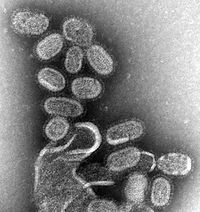
Photo from wikipedia
Baloxavir is an anti-influenza endonuclease inhibitor that targets the polymerase acidic (PA) protein of influenza A and B viruses. Our knowledge regarding the pleiotropic effects of baloxavir resistance-associated substitutions is… Click to show full abstract
Baloxavir is an anti-influenza endonuclease inhibitor that targets the polymerase acidic (PA) protein of influenza A and B viruses. Our knowledge regarding the pleiotropic effects of baloxavir resistance-associated substitutions is limited. ABSTRACT Baloxavir is an anti-influenza endonuclease inhibitor that targets the polymerase acidic (PA) protein of influenza A and B viruses. Our knowledge regarding the pleiotropic effects of baloxavir resistance-associated substitutions is limited. We generated recombinant A/California/04/09 (H1N1)-, A/Hong Kong/218849/2006 (H3N2)-, and B/Victoria/504/2000-like viruses that contained PA substitutions identified in baloxavir clinical trials and surveillance that could potentially be associated with baloxavir resistance. We characterized their susceptibility to baloxavir, impact on polymerase activity, viral growth, and ability to induce interferon (IFN) and IFN-stimulated genes expression in vitro. Four PA substitutions, H1N1 I38L/T, E199D, and B G199R, significantly reduced the sensitivity of the recombinant viruses to baloxavir (14.1-fold). We confirmed our findings by using the luciferase-based ribonucleoprotein minigenome assay and by using virus yield reduction assay in Calu-3 and normal human bronchial epithelial (NHBE) cells. We observed that I38L and E199D resulted in decreased viral replication of the H1N1 wild-type virus (1.4-fold) but the H1N1 I38T and B G199R substitutions did not significantly alter replication capacity in Calu-3 cells. In addition, H1N1 variants with PA I38L/T and E199D induced significantly higher levels of IFNB1 gene expression compared to the wild-type virus (4.2-fold). In contrast, the B variant, G199R, triggered the lowest levels of IFN genes in Calu-3 cells (1.6-fold). Because baloxavir is a novel anti-influenza therapeutic agent, identifying and characterizing substitutions associated with reduced sensitivity to baloxavir, as well as the impact of these substitutions on viral fitness, is paramount to the strategic implementation of this novel countermeasure.
Journal Title: Antimicrobial Agents and Chemotherapy
Year Published: 2022
Link to full text (if available)
Share on Social Media: Sign Up to like & get
recommendations!